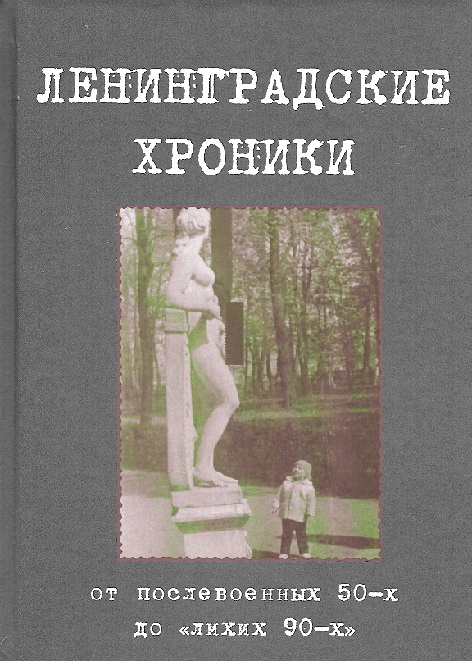
L международная выставка-презентация
научных, технических, учебно-методических и литературно-художественных изданий
Ленинградские хроники: от послевоенных 50-х до «лихих 90-х»

| Группа | Документальная проза (нон-фикшн) |
|---|---|
| Название на русском языке | Ленинградские хроники: от послевоенных 50-х до «лихих 90-х» |
| Авторы на русском языке | Байков В.Д. |
| Название на английском языке | The Leningrad chronicles: from the post-war fifties to the „wild nineties“ |
| Авторы на английском языке | Baykov V.D. |
| Издательство на русском языке | Москва: издательство «Карамзин», 2017. - 484 с. |
Резюме
Эта книга отличается от многих мемуарных изданий тем, что в ней описываются не биографические факты одного конкретного лица, а жизненные реалии первого послевоенного поколения ленинградцев. Ярко и образно изложены многочисленные детали быта, досуга, учебы и работы. Приведено много повседневных сценок, которые позволяют представить жизнь ленинградцев на протяжении второй половины двадцатого столетия.
Cсылки на данное издание имеются в списках рекомендованной литературы программ исторического факультета Московского государственного университета, Международного института социальной истории.
Книга приобретена более чем двумя десятками библиотек европейских и американских университетов.
Abstract
The book considerably differs from many memoirs editions. First of all not only the biographic facts of one particular person are described, but there are also many lifelike realities of the first post-war generation of Leningrad residents. Numerous details of life, leisure, study and work also are brightly described. Many everyday sketches allow to recall life of Leningrad residents throughout the second half of the twentieth century.
The book is addressed not only to those readers whose childhood have fallen on these years, but it will be also interesting and useful to the young people who are trying to understand that time.
In the book life of residents on Neva, since the period right after completion of World War II is described. On a number of examples it is shown that there are a lot of habits of the military period of life of the Leningrad inhabitants, were transferred as well to post-war period. These are, first of all, meetings at a table, choral singing, the organization of the joint preparation for holidays, evening potlucks and also favourite songs and dances after gramophone records, house dances under a record player.
Life of children and pupils of school in the period of the end of the fortieth, the beginning of the fiftieth years: children's and youthful sport. Ridiculous draws, nicknames, teenage slang. Popularity of sport among youth, popular heroes of sports duels, admirers of the football matches broadcast on radio.
The self-made skates with valenki (felt boots), self-made "Finnish" sledge. Merging of men's and women's schools, event in the mid-fifties. Introduction of a school uniform for boys.
Amnesty of the beginning of the fiftieth years, mass emergence after Stalin's death amnestied from prisons and camps in the cities. "Fashion" during this period for the Russian boots, and short coats.
In the book it is paid much attention on the description of clothes style and footwear of those years. Transition from single-breasted coats and the altered soldier's soldier's blouses to more modern and fashionable clothes. Raincoats from the covert coat and gabardine, fabrics from free wool, copying of the American pre-war fashion - raglans, Fedora hats. Female couplings and silver foxes
Life without vacuum cleaners and refrigerators. The big time spent for ironing of trousers, cleaning of boots and care of parquet floors. The special value of coins advantage in two kopeks in the period of chargeable street payphones. As it was possible to go to restaurants, cafe and hotels.
Businessmen of time before reorganization, buying up of things from hands at foreigners, speculation. Trips abroad.
Favourite transfers, concerts according to statements of radio listeners. Joint viewing of the first telecasts together with neighbours. Record on tape recorders of the jazz music passed by foreign broadcasting stations.
Concerts of amateur authors of songs. The first jazz festivals. Emergence and mass hobby for video recorders. Centres of a hire of videotapes, video salons.
Deficiency of the books. The literature is selling according only by coupons, a subscription to collected works, a subscription on production to newspapers and magazines. Voluntary subscription for the party Life of Research Institute and Educational Higher Educational Institutions newspapers, universities. Seasonal agricultural works of students and research associates. Mass suburban weekend tourism. Amateur photographers and amateur video recorders.
Beginning of Perestroika. The amateur markets, musicians on streets and in trains. Quickly growing prices. Introduction of coupons, kingdom of barter. The first cooperatives and the first racketeers. Record circulation of newspapers of Perestroika and magazines. Television psychics and clairvoyants.
The book is richly illustrated by tens of the photos taken from the family album of the author.
References to this book are specified in the list of recommended literature for the postgraduate students of the History Department of the Moscow State University, International Institute of Social History and also this book is indicated in the library catalogues of many European and American universities.
